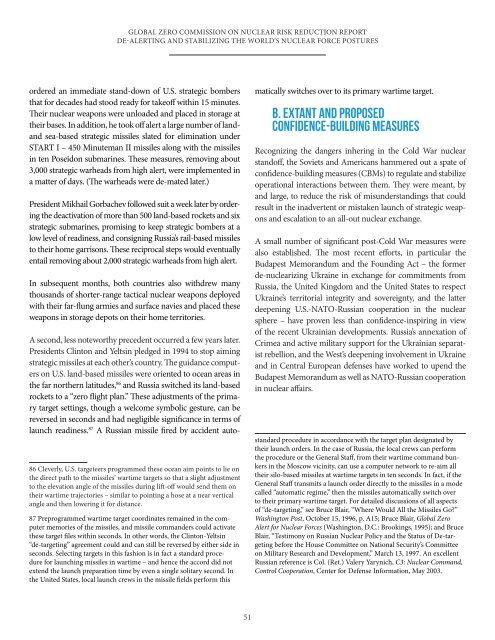global_zero_commission_on_nuclear_risk_reduction_report
global_zero_commission_on_nuclear_risk_reduction_report
global_zero_commission_on_nuclear_risk_reduction_report
Create successful ePaper yourself
Turn your PDF publications into a flip-book with our unique Google optimized e-Paper software.
GLOBAL ZERO COMMISSION ON NUCLEAR RISK REDUCTION REPORTDE-ALERTING AND STABILIZING THE WORLD’S NUCLEAR FORCE POSTURESordered an immediate stand-down of U.S. strategic bombersthat for decades had stood ready for takeoff within 15 minutes.Their <strong>nuclear</strong> weap<strong>on</strong>s were unloaded and placed in storage attheir bases. In additi<strong>on</strong>, he took off alert a large number of landandsea-based strategic missiles slated for eliminati<strong>on</strong> underSTART I – 450 Minuteman II missiles al<strong>on</strong>g with the missilesin ten Poseid<strong>on</strong> submarines. These measures, removing about3,000 strategic warheads from high alert, were implemented ina matter of days. (The warheads were de-mated later.)President Mikhail Gorbachev followed suit a week later by orderingthe deactivati<strong>on</strong> of more than 500 land-based rockets and sixstrategic submarines, promising to keep strategic bombers at alow level of readiness, and c<strong>on</strong>signing Russia’s rail-based missilesto their home garris<strong>on</strong>s. These reciprocal steps would eventuallyentail removing about 2,000 strategic warheads from high alert.In subsequent m<strong>on</strong>ths, both countries also withdrew manythousands of shorter-range tactical <strong>nuclear</strong> weap<strong>on</strong>s deployedwith their far-flung armies and surface navies and placed theseweap<strong>on</strong>s in storage depots <strong>on</strong> their home territories.A sec<strong>on</strong>d, less noteworthy precedent occurred a few years later.Presidents Clint<strong>on</strong> and Yeltsin pledged in 1994 to stop aimingstrategic missiles at each other’s country. The guidance computers<strong>on</strong> U.S. land-based missiles were oriented to ocean areas inthe far northern latitudes, 86 and Russia switched its land-basedrockets to a “<str<strong>on</strong>g>zero</str<strong>on</strong>g> flight plan.” These adjustments of the primarytarget settings, though a welcome symbolic gesture, can bereversed in sec<strong>on</strong>ds and had negligible significance in terms oflaunch readiness. 87 A Russian missile fired by accident auto-86 Cleverly, U.S. targeteers programmed these ocean aim points to lie <strong>on</strong>the direct path to the missiles’ wartime targets so that a slight adjustmentto the elevati<strong>on</strong> angle of the missiles during lift-off would send them <strong>on</strong>their wartime trajectories – similar to pointing a hose at a near verticalangle and then lowering it for distance.87 Preprogrammed wartime target coordinates remained in the computermemories of the missiles, and missile commanders could activatethese target files within sec<strong>on</strong>ds. In other words, the Clint<strong>on</strong>-Yeltsin“de-targeting” agreement could and can still be reversed by either side insec<strong>on</strong>ds. Selecting targets in this fashi<strong>on</strong> is in fact a standard procedurefor launching missiles in wartime – and hence the accord did notextend the launch preparati<strong>on</strong> time by even a single solitary sec<strong>on</strong>d. Inthe United States, local launch crews in the missile fields perform thismatically switches over to its primary wartime target.B. EXTANT AND PROPOSEDCONFIDENCE-BUILDING MEASURESRecognizing the dangers inhering in the Cold War <strong>nuclear</strong>standoff, the Soviets and Americans hammered out a spate ofc<strong>on</strong>fidence-building measures (CBMs) to regulate and stabilizeoperati<strong>on</strong>al interacti<strong>on</strong>s between them. They were meant, byand large, to reduce the <strong>risk</strong> of misunderstandings that couldresult in the inadvertent or mistaken launch of strategic weap<strong>on</strong>sand escalati<strong>on</strong> to an all-out <strong>nuclear</strong> exchange.A small number of significant post-Cold War measures werealso established. The most recent efforts, in particular theBudapest Memorandum and the Founding Act – the formerde-<strong>nuclear</strong>izing Ukraine in exchange for commitments fromRussia, the United Kingdom and the United States to respectUkraine’s territorial integrity and sovereignty, and the latterdeepening U.S.-NATO-Russian cooperati<strong>on</strong> in the <strong>nuclear</strong>sphere – have proven less than c<strong>on</strong>fidence-inspiring in viewof the recent Ukrainian developments. Russia’s annexati<strong>on</strong> ofCrimea and active military support for the Ukrainian separatistrebelli<strong>on</strong>, and the West’s deepening involvement in Ukraineand in Central European defenses have worked to upend theBudapest Memorandum as well as NATO-Russian cooperati<strong>on</strong>in <strong>nuclear</strong> affairs.standard procedure in accordance with the target plan designated bytheir launch orders. In the case of Russia, the local crews can performthe procedure or the General Staff, from their wartime command bunkersin the Moscow vicinity, can use a computer network to re-aim alltheir silo-based missiles at wartime targets in ten sec<strong>on</strong>ds. In fact, if theGeneral Staff transmits a launch order directly to the missiles in a modecalled “automatic regime,” then the missiles automatically switch overto their primary wartime target. For detailed discussi<strong>on</strong>s of all aspectsof “de-targeting,” see Bruce Blair, “Where Would All the Missiles Go?”Washingt<strong>on</strong> Post, October 15, 1996, p. A15; Bruce Blair, Global ZeroAlert for Nuclear Forces (Washingt<strong>on</strong>, D.C.: Brookings, 1995); and BruceBlair, “Testim<strong>on</strong>y <strong>on</strong> Russian Nuclear Policy and the Status of De-targetingbefore the House Committee <strong>on</strong> Nati<strong>on</strong>al Security’s Committee<strong>on</strong> Military Research and Development,” March 13, 1997. An excellentRussian reference is Col. (Ret.) Valery Yarynich, C3: Nuclear Command,C<strong>on</strong>trol Cooperati<strong>on</strong>, Center for Defense Informati<strong>on</strong>, May 2003.51


